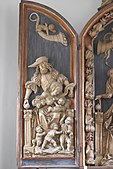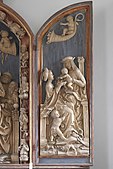Bieselbach Altar
The Bieselbach Altar is a late Gothic winged altar from the Ulm School with a representation of the Holy Tribe . It was probably carved from limewood in 1510 by the sculptor Daniel Mauch (around 1477–1540) .
The altar is in the Catholic chapel Franz-Xaver in Bieselbach , a district of Horgau , in the Augsburg district in the Bavarian administrative district of Swabia .
history
The origin and sponsor of the altar cannot be clearly identified. The altar probably comes from the castle of the Rehlinger patrician family, which was demolished in 1813 . Johann Rehlinger (1483–1552) and his wife Anna Dietenheimer, whose daughter Anna married Anton Fugger in 1527 , may have commissioned the altar. This is also indicated by the alliance coat of arms at the top of the shrine . In 1911/12 a carved signature was discovered on the base of the Jesse figure : "maich bildhaer zv vlm 150X". The year cannot be deciphered exactly, 1510 is assumed to be the year of origin.
In 1747 a chapel dedicated to St. Franz Xavier (1506–1552) was built in Bieselbach on the site of a wooden crucifix , to which the Bieselbach Altar was transferred in 1756.
Restoration and current condition
In 1954/55 the overpainting was removed and the original, wood-transparent surface of the sculptures exposed against a blue-gray background, as well as the original color tones of the lips, cheeks and eyes. The outside of the side wings, which were originally unpainted, have been painted with the depiction of the Annunciation since 1835 .
The altar consists of a central shrine, a pair of movable wings and a predella . The crucifixion group of the altarpiece was added in 1853. It is attributed to Daniel Mauch's circle.
iconography
Representations of the holy clan were a popular subject from the second half of the 15th century. It was often used for winged altars in Daniel Mauch's workshop. The idea of the holy clan is based on the Legenda aurea , a medieval collection of saints legends and the so-called doctrine of the trinubium . After that, St. Anna was married three times and, besides Mary , the mother of Jesus, had two other daughters, all of whom were named Mary. According to legend, the later apostles James the Younger , Barnabas , Simon Zelotes and Judas Thaddäus as well as the apostles James the Elder and John emerged from the marriages of these two Marys .
People are depicted in rich bourgeois costume with headgear and hairstyles from around 1500. The little dogs with which the children play are interpreted as a sign of marital fidelity. The lions symbolize male strength. The opened walnut that John holds in his hand is a symbol of the Passion of Christ. The wooden bowl indicates the cross and the inner core indicates the divine nature of Christ.
The decor of cornucopia, putti , fruit baskets and garlands already refers to the Renaissance .
shrine
On the middle part, the shrine , the group of figures Anna herself is depicted. Saint Anne and Mary, behind whom the aged Joseph stands, sit on a throne. The baby Jesus is sitting on Mary's lap , reaching for a ball or fruit that St. Anna hands him. Behind Anna are her three husbands, Joachim , Cleophas and Salomas. The scene is framed by prophets and kings of the Old Testament who grow out of artistically designed flowers.
Left wing
On the left wing is Maria Cleophas , Anna's daughter from the marriage with her second husband Cleophas. Behind Maria Cleophas is her husband Alphäus and in the foreground her four children, the later apostles James the Younger , Barnabas , Simon Zelotes and Judas Thaddäus .
Right wing
On the right wing are shown Maria Salomas , Anna's daughter from her third marriage to Salomas, her husband Zebedee and their two children. Zebedee holds the future apostle John in his arms, at the feet of Maria Salomas stands the later apostle James the Elder .
Predella
The figure of the predella originally represented the root of Jesse . A sprout with the ancestors of Jesus grew out of Jesse's chest and continued up to the coat of arms in the hollow of the shrine. When the altar was moved to the newly built Franz Xaver Chapel, the figure of Franz Xaver , the Jesuit missionary and patron of the chapel, was reworked and given new attributes .
literature
- Georg Dehio: Handbook of the German art monuments. Art monuments Bavaria III: Swabia . (revised by Bruno Bushart and Georg Paula), Deutscher Kunstverlag, Munich 1989, ISBN 3-422-03008-5 , pp. 189–190.
- Norbert Lieb: The Bieselbach Chapel . (= Small Art Guide No. 772), Verlag Schnell and Steiner, Munich and Zurich 1963.
- Gertrud Roth-Bjadzhiev: The churches of the parish Horgau . (= Small Art Guide No. 421), 2nd edition, Verlag Schnell and Steiner, Regensburg 2004, ISBN 978-3-7954-5916-1 .
Web links
Individual evidence
- ^ Bieselbach ( Memento from February 16, 2013 in the Internet Archive )
Coordinates: 48 ° 23 ′ 37.5 ″ N , 10 ° 39 ′ 17.3 ″ E







